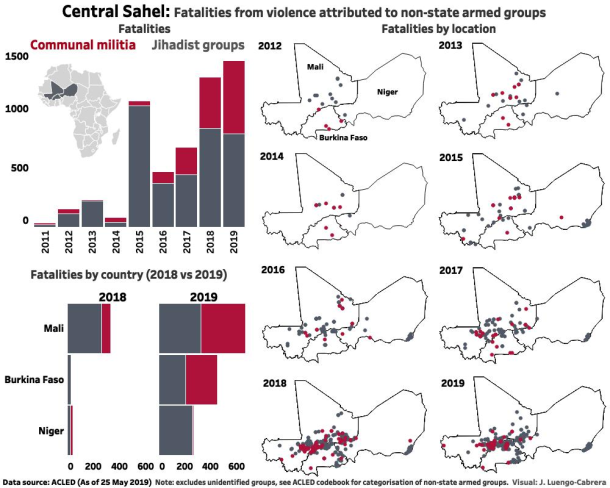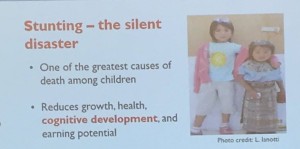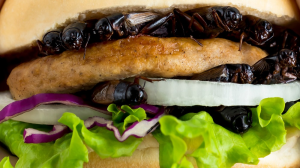A monthly round-up of recent articles, blog postings and tweets about livestock, aid and other topics that may be of interest to International Livestock Research Institute (ILRI) staff and partners, compiled by David Aronson.
ILRI East Asia representative Hung Nguyen-Viet is quoted extensively in this article in ASEAN Today on the spread of African swine fever (ASF) into Vietnam. The scale of the problem is hard to understate: An estimated three million households in Vietnam rely on pork production for their livelihoods. And as Hung explains, ‘Many households have completely lost their herds. Some families with medium farm size have lost up to USD 50,000 because of ASF’.
(This article from Bloomberg says that China has severely mismanaged the ASF crisis, and that up to 130 million pigs—or roughly one out of every three in China—may eventually have to be culled because of it.)
ILRI’s participatory research scientist John Recha has recently been featured on several Kenyan news shows, discussing the importance of enhancing and improving agricultural productivity and income in the face of climate change, here, here, here and on an hour-long show here on KTN. He’s also been quoted extensively in stories in the Star and the Standard. Congratulations to John for his great work communicating to broader Kenyan audiences about the work that we do!
An article in The Telegraph, based on a paper just published in Lancet Planetary Health written by researchers from the University of Liverpool and ILRI’s Eric Févre, warns that urban wildlife such as birds and bats may be spreading superbugs around the cities of developing nations because of poor management of human and animal waste.
Joseph Ogutu, formerly of ILRI, has new research out showing how the Maasai Mara national reserve is threatened: ‘Activities by people – like farming, erecting fences and settlements – are proliferating around the borders of the core protected areas. This is putting huge pressure on the area’s environment, natural resources and wildlife’, he writes.
If you like your ironies sunny-side down, the New York Times columnist Nicholas Kristof has an op-ed on the astounding inequalities in the global economic system, where a quarter of the world’s children are stunted by malnutrition but a restaurant on the Upper East Side of Manhattan charges USD 214 for a grilled cheese sandwich.
A sustained drought is threatening up to two million lives in Somalia this year, says the UN’s Office for Humanitarian Affairs. A similar crisis is underway in South Sudan, where some seven million people face food shortages and more than 20,000 are close to famine.
 More on the rising conflicts in central Sahel: less than halfway through 2019, total fatalities from violence attributed to jihadist groups & communal militia have surpassed the toll in all (full) years since 2012.
More on the rising conflicts in central Sahel: less than halfway through 2019, total fatalities from violence attributed to jihadist groups & communal militia have surpassed the toll in all (full) years since 2012.
Meanwhile, a new study from Adelphi says that these conflicts are fuelled not by climate change or ethno-politics or competition over land, but by neo-pastoralists, urban elites who are increasingly militarizing the movement of livestock, and whose large livestock holdings exacerbate the herder-farmer tensions.
To understand why these conflicts are attracting so much attention from national security agencies in the West, here is how France’s defense minister, Florence Parly, puts it: ‘If we do not stabilise Mali, Niger or Burkina Faso, Europe will have above its head, not one, but two lasting Damocles swords: that of terrorism … and that of illegal migration.’
Conflicts over cows allegedly being brought in by immigrant communities are worsening in the Ituri district of DR Congo (French). And more here. Similar conflict are emerging to the west, in Kisangani. This is worrisome because state institutions in Congo are exceptionally weak, and conflicts there have a way of persisting for years or even decades.

A striking photo on stunting from Lora Ianotti
This photo, from Lora Ianotti, taken from a conference presentation of twins born in Guatemala, one raised in US and the other in Guatemala, is perhaps the most powerful image I’ve seen yet on the impact of stunting on children’s lives:
A new study from Barclays Research finds that plant-based meat may not be any healthier the hoof-based stuff. In a related story, Barclays projected that alternative meats could become a USD 140 billion industry within the decade. Another research consultancy, at Kearney, predicts that 60% of ‘meat’ consumed worldwide will come from the lab or plants by 2040. However, still another consultancy finds that consumer acceptance of plant-based meat remains relatively low.
Here is how Burger King is advertising the meatless Whopper. The supplier of the meatless burger is struggling to meet the surging demand. Tyson’s, one of the largest meatpacker in the US, has pulled out of one partnership and is now racing to develop its own meatless foods. And here is an interview with the founder of Beyond Meat.

It’s a work in progress.
Another company is betting on lab-grown insect meat, genetically modified for maximum growth, which could “combine the planet-saving best of insect farming, GM livestock, labriculture and plant-based meat substitutes.” I’m pretty sure the photo the editor picked to go along with the article isn’t going to help their cause:
The race is on to replace the egg, as well as meat, and it too is a multi-billion dollar business.
‘The Science is Clear: It’s Time to Act!’ says the perfectly coiffed TV blonde—so you know it must be true. The Eat Stockholm Food Forum 2019 launched on 12 June. For a more nuanced discussion, these delegates to the conference argue that investments in lab meat are unlikely to impact vast swathes of the globe whose primary challenge is access to nutritious foods — or food of any kind — rather than over-consumption of red meat.
Of course, we all know what the race to replace meat is really all about, as right-wing US pastor Rick Wiles explains: Plant-based meat alternatives like the Impossible Burger, he says, are part of a ‘satanic plot to change human DNA [and] ‘create a race of soulless creatures’ incapable of worshiping God. (This may not seem wholly, 100% evidence-based to you or me, but it would be a mistake to underestimate the political strength of groups like this in the US. It’s also yet another indication of how politicized the debate over meat substitutes is becoming there.)
A good brief discussion on whether agriculture can create jobs for Africa’s burgeoning youth can be found beginning on page 50 of the AFDB report.
The World Bank has allocated USD350 million for pastoralists in Ethiopia. Of the total, USD280 million will be provided in the form of concessional credit and USD70 million in the form of grants.
Space-age breeding technologies are ‘tricking’ staple crops into growing up to six generations of wheat, barley, chickpeas and canola in a year, whereas traditional methods would only yield one or two. A new variety of Durum wheat, developed by ICARDA, can withstand 40C heat, and could soon be producing 600,000 tonnes of food along the Senegal River basin.
Thinking about starting a chicken farm here in Kenya? This looks like an excellent on-line course to get you started. Chicken farmers in Kenya are feeding their birds fly larvae grown using human waste gathered in Kibera.
A quick review of Norman Borlaug’s life and work, and how he proved Paul Ehrlich wrong.
 The opposite of what Malthus (and Ehrlich) predicted: the world in producing more and more food per person in an increasingly efficient way.
The opposite of what Malthus (and Ehrlich) predicted: the world in producing more and more food per person in an increasingly efficient way.
New DNA analysis shows that African herders and foragers mated with each other in two phases, between 4,000 and 6,000 years ago. The study suggests that ancient African hunter-gatherers mated with early herders rather than simply adopting their livestock practices. More on that study here.
Tanzania is planning to boost dairy production.
The next superfood? Glaswegians are drinking cappuccinos made from camel milk from east Africa, part of a burgeoning market for camel dairy products ranging from baby milk to chocolate bars, pizzas to frappuccinos.
A good run-down on the state of research on vaccines that don’t need refrigeration. Only 7 percent of children in the world’s poorest 73 countries receive all the doses of all the recommended vaccines, in part because the vaccines need to be kept cold—a major challenge in developing countries.
Fears of Ebola contagion have greatly slowed down commerce at the Uganda-DRC border, driving down the price fishermen receive by half.
More dismaying news on anti-microbial resistance front: Tigecycline, a potent antibiotic of last resort used against E. Coli and pneumonia and other life-threatening illnesses is under threat from swiftly spreading bacterial genes that allow microbes to shrug off the drug’s effects.
The largest survey ever conducted on public attitudes towards science and health has found that poor countries are generally more trusting of science than people in rich countries. For example, 99% of people in Rwanda believe vaccines are safe, compared to only 47% of people in France.
A good rundown on the UC-Davis conference last month on Aligning the Food System for Improved Nutrition in Animal-Source Foods, which focused equally on the health consequences of meat consumption and on the environmental impacts and sustainability of ASF production.
To equal the milk produced by one dairy cow in the USA in 2017 you needed:
🐄🐄🐄🐄🐄🐄🐄🐄🐄🐄🐄🐄🐄🐄🐄🐄 in Kenya
🐄🐄🐄🐄🐄🐄🐄 in India
🐄🐄🐄🐄🐄 in Ecuador
Don’t tax meat; tax processed highly processed food, argues Richard Young, of the Sustainable Food Trust.
What do women want? It may not be the most original question ever, but this essay argues that we overuse the term “empowerment” and often fail to simply ask women what they want and respond accordingly.
A new exhibit on the future of food at the Victoria and Albert Museum in London features some, um, inventive possibilities, says the Economist, including that of a partnership between a microbiologist and an artist who specialises in smell, who make cheeses out of microbial samples from human skin.
UK-based company Deep Branch Biotechnology has recently finished testing a method for turning carbon dioxide into animal feed.
South African farmers are tagging their sheep and cattle with electronic monitoring to stymy widespread theft.
Six Nigerians fall into extreme poverty every minute, outstripping the country’s economic growth.
Mona Chalabi’s art work vividly illustrates social and scientific issues, and provides a model of how to inventively illustrate scientific concepts.
Scientists come from all over the world, so how do they cope with English being the dominant language of scientific discourse? Some interesting interviews with diverse researchers.
Your factlet of the day, from the always delightful Haggard Hawks: As a word for a young pig, the word PIGLET only dates back to the mid 1800s. Before then, a young pig might be called a HOGLING (14thC), a PORKET (1550s), a HOG-BABE (1600s), or a GRUNTLING (1680s).
And finally, as part of our continuing series, Goats: What Can’t They Do?, here is a picture of a goat monitoring the vote in Dorset County, UK.

Monitoring the vote in Dorset County, UK
